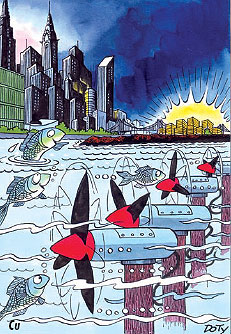Currents of Change
 High-resolution version of this photo.
High-resolution version of this photo.Rising energy bills, coupled with a growing awareness of the environmental impact of burning fossil fuels, have made finding alternative, renewable energy sources a critical priority here in the United States and abroad.
From tidal turbines submerged in Manhattan's East River to wind farms in the western states, sustainable energy solutions across America share one important element - they all rely on copper and its electrical conducting properties to generate and distribute electricity.
It's a Windy World
Most of the energy plants operating in the USA burn coal to power mechanical systems that generate electricity. However, the use of natural, renewable energy resources like the sun and wind are on the rise.
Wind energy, in particular, has been deemed the fastest growing source of power generation worldwide, according to the American Wind Energy Association (AWEA), which lists the United States second only to Germany in wind-based power capabilities.
While the concept of using wind power is not new, the sleek, aerodynamic designs of today's wind turbines bear little resemblance to the rural windmills once used to pump water or grind grain.
Mounted on towers 235- to 300-feet tall to take advantage of faster and less turbulent wind, a modern wind turbine generally has three propeller-like blades attached to a rotor. When the rotor is in motion, it turns a drive shaft that spins a mechanical arm wound with copper wire. Magnets placed on either side of the spinning arm react to the motion of the copper wire, generating an electric current.
Copper is used in even greater quantities to connect wind turbines grouped together in "wind farms" to provide power for entire cities.
Underwater Turbines in the East River
Copper plays a similar role in the world's first farm of tide-powered turbines in New York City's East River.
A series of 15-foot tall turbines are being installed in the river, where rapid water currents - among the fastest on the East Coast - will one day, hopefully, power generators that will produce 10 megawatts of electricity (enough to power 8,000 homes), when the project is completed in 2006.
The $20 million project, currently being installed by Verdant Power of Virginia, is expected to employ up to 300 turbines mounted on pilings affixed to the river basin some 30 to 40 feet below the surface. The propellers are about eight feet below the water's surface and move slowly enough that they do not harm aquatic life.
With support from the New York State Energy Research and Development Authority (NYSERDA), Verdant ran a five-week trial in 2002 using one turbine. The project is currently in its second phase - with six turbines now operating in the river that will provide energy to residents and businesses on nearby Roosevelt Island.
Underwater Turbines in the East River
New advances in solar energy technology include the discovery of a thin-film technology made from Copper Indium Diselenide (CuInSe2 or CIS), which has been shown to increase the energy efficiency of solar cells. This new type of cell costs up to 10 times less than current silicon-based photovoltaic cells and has the potential to make solar power more attractive to architects and builders.
To learn more about some of the renewable energy sources cited in this article, visit our Copper Topics section. Cu
Resources:
American Wind Energy Association
U.S Government's National Renewable Energy Laboratory (NREL)
U.S. Department of Energy National Center for Photovoltaics
U.S. Department of Energy's Office of Energy Efficiency and Renewable Energy (DOE/EERE)
Also in this Issue:
- Currents of Change
- Copper Rotors Save Energy
- Biosphere 2 Depends On Copper
- Computer Chips Built For Speed
